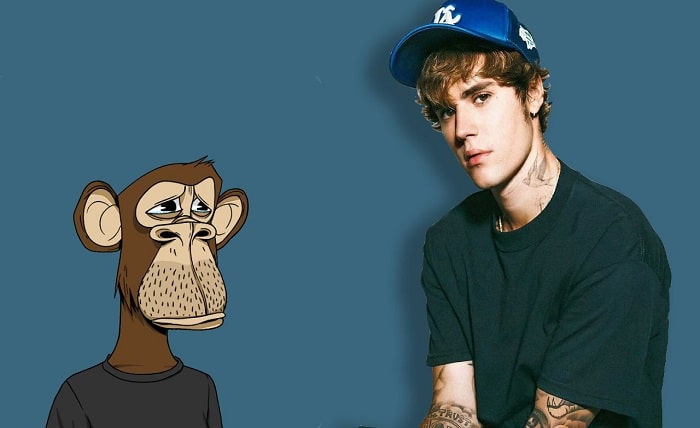Justin Bieber’s NFT Nightmare: How the Pop Star Lost Over $1.2 Million on a Bored Ape

Justin Bieber is one of the most successful and influential artists of his generation, with millions of fans and countless awards. However, he is also one of the latest victims of the volatile and risky world of non-fungible tokens (NFTs), a form of digital art that uses blockchain technology to create unique and scarce digital assets. In January 2022, Bieber bought a Bored Ape NFT for a whopping $1.3 million, hoping to join the exclusive club of celebrities and collectors who own these pixelated primates. However, less than two years later, his NFT has plummeted in value by more than 95%, leaving him with a staggering loss of over $1.2 million. How did this happen, and what does it mean for the future of NFTs? Here is everything you need to know about Justin Bieber’s NFT nightmare.
What is a Bored Ape NFT?
A Bored Ape NFT is a digital image of an anthropomorphic ape with various traits and accessories, such as hats, glasses, fur colors, and facial expressions. There are 10,000 Bored Apes in total, each with a unique combination of features that make them rare and desirable. The Bored Apes are part of the Bored Ape Yacht Club (BAYC), a collection of NFTs created by Yuga Labs, a mysterious group of developers who launched the project in April 2021.
The Bored Apes are not just images, but also tokens that grant their owners access to a virtual community and exclusive perks, such as merchandise, events, games, and collaborations. The Bored Apes have become one of the most popular and valuable NFT collections in the market, attracting celebrities, athletes, musicians, and influencers who want to show off their status and support the project. Some of the famous Bored Ape owners include Jimmy Fallon, Paris Hilton, Post Malone, Steph Curry, Snoop Dogg, and of course, Justin Bieber.
How much did Justin Bieber pay for his Bored Ape NFT?
Justin Bieber bought his Bored Ape NFT on January 10th, 2022, from an online marketplace called OpenSea, where users can buy and sell NFTs using cryptocurrencies such as Ethereum (ETH). Bieber paid 500 ETH for his Bored Ape, which was equivalent to $1.29 million at the time. His Bored Ape has the serial number #3001 and features a teary-eyed expression, a blue bandana, and brown fur.
Bieber announced his purchase on his Instagram account, where he posted a picture of his Bored Ape along with the lyrics of his song “Lonely”, which talks about the struggles of fame and isolation. He also tagged Moonpay, a payment platform that enables users to buy cryptocurrencies and NFTs with fiat money. Some speculated that Bieber’s purchase was part of a promotional deal with Moonpay, but neither party confirmed or denied this.
Bieber’s purchase was widely reported by the media and generated a lot of buzz in the NFT community. However, it also raised some eyebrows among critics who questioned his decision to pay such a high price for a low-quality image that had no artistic merit or cultural significance. Some also pointed out that Bieber paid five times more than the market value of his Bored Ape at the time, which was around 100 ETH or $260,000.
Read more about : 99math
How much is Justin Bieber’s Bored Ape NFT worth now?
Unfortunately for Bieber, his Bored Ape NFT has not been a good investment. Since he bought it in January 2022, the value of his NFT has plummeted by more than 95%, according to OpenSea data. As of July 5th, 2023, the highest offer for his Bored Ape was 22 ETH or $56,293, which means that he has lost over $1.2 million on his purchase.
There are several reasons why Bieber’s Bored Ape NFT has lost so much value in such a short period of time. One of them is the general decline of the NFT market, which has been affected by the volatility and uncertainty of the cryptocurrency market. The price of Ethereum, which is used to buy and sell most NFTs, has dropped by more than 50% since its peak in May 2021. This has reduced the demand and liquidity for NFTs across the board.
Another reason is the oversaturation and competition in the NFT space, which has seen an explosion of new projects and collections that try to replicate or surpass the success of the Bored Apes. Some of these projects include the Mutant Ape Yacht Club, the Cool Cats, the CryptoPunks, the Meebits, and the Stoned Ape Gang. These projects offer different features, styles, and benefits to their owners, making the Bored Apes less unique and appealing.
A third reason is the lack of innovation and engagement from the Bored Ape Yacht Club team, which has failed to deliver on its promises and expectations. The Bored Ape Yacht Club was supposed to be more than just a collection of images, but a vibrant and interactive community that would offer exclusive content and experiences to its members. However, the team has been slow and inconsistent in providing updates, announcements, and events that would keep the Bored Ape owners interested and satisfied.
Read more about: vegamovies
What does Justin Bieber’s NFT nightmare mean for the future of NFTs?
Justin Bieber’s NFT nightmare is a cautionary tale for anyone who wants to invest in NFTs, especially those who are not familiar with the technology and the market. NFTs are not a get-rich-quick scheme, but a highly speculative and risky venture that requires a lot of research, due diligence, and patience. NFTs are not guaranteed to increase in value over time, but can also lose their value dramatically due to various factors that are beyond the control of the owners.
Read more about : revolver news
Conclusion
NFTs are also not a substitute for real art or culture, but a new form of expression and communication that has its own merits and challenges. NFTs can be used to create and share original and meaningful works that can inspire and empower people, but they can also be used to produce and sell low-quality and meaningless works that can exploit and deceive people. NFTs are not inherently good or bad, but depend on how they are created and used by their creators and owners.
NFTs are still a new and evolving phenomenon that has a lot of potential and possibilities, but also a lot of pitfalls and uncertainties. NFTs are not for everyone, but for those who are willing to learn, experiment, and innovate with them. NFTs are not the end, but the beginning of a new era of digital art and culture.



